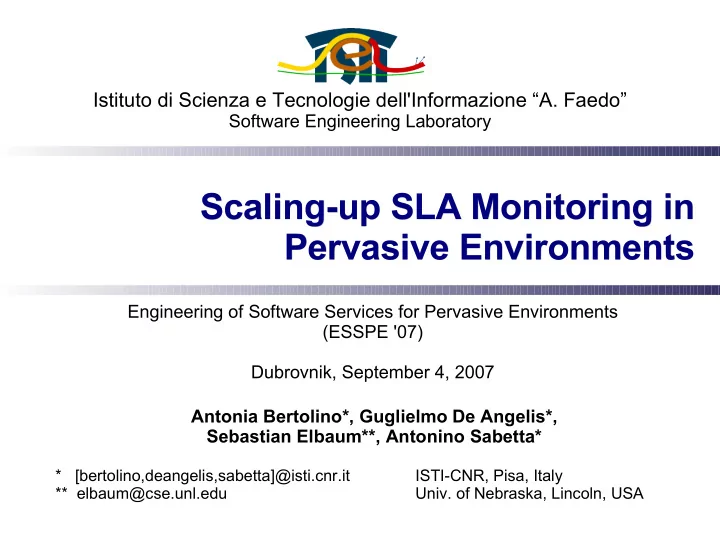

Istituto di Scienza e Tecnologie dell'Informazione “A. Faedo” Software Engineering Laboratory Scaling-up SLA Monitoring in Scaling-up SLA Monitoring in Pervasive Environments Pervasive Environments Engineering of Software Services for Pervasive Environments (ESSPE '07) Dubrovnik, September 4, 2007 Antonia Bertolino*, Guglielmo De Angelis*, Sebastian Elbaum**, Antonino Sabetta* * [bertolino,deangelis,sabetta]@isti.cnr.it ISTI-CNR, Pisa, Italy ** elbaum@cse.unl.edu Univ. of Nebraska, Lincoln, USA
Motivation and Context » To enable QoS management in pervasive systems » To check SLAs and to report violations in an efficient and timely manner SOFTWARE ENGINEERING LABORATORY
Example scenario » Fraud detection services (FDS): » For online sellers: to detect suspicious transactions and illegitimate payments » For buyers: to verify that sellers can be trusted (e.g. items sold are authentic) » Different types of service requests, depth of checks, users, locations SOFTWARE ENGINEERING LABORATORY
Example scenario » Services accessed through many different pervasive devices » Clients may have different profiles and QoS requirements » SLAs can be complex, and possibly involve application-specific conditions » QoS level, which would otherwise be fine, might suffer just because we are monitoring it Requests coming from users of class GOLD who have been registered for more than a year and have used the service less than 10 times in the last hour must be served in less than 1500ms. SOFTWARE ENGINEERING LABORATORY
Checking SLAs is not weightless! how many clients we can't afford serving because we are busy ? monitoring (irrelevant events)? SOFTWARE ENGINEERING LABORATORY
Different clients, different “distance from violation” QoS time=t1 metric X clients SOFTWARE ENGINEERING LABORATORY
Different clients, different “distance from violation” QoS time=t2 metric X clients SOFTWARE ENGINEERING LABORATORY
Different clients, different “distance from violation” QoS time=t3 metric X clients SOFTWARE ENGINEERING LABORATORY
Different clients, different “distance from violation” QoS time=t4 metric X clients SOFTWARE ENGINEERING LABORATORY
Different clients, different “distance from violation” QoS time=t5 metric X clients SOFTWARE ENGINEERING LABORATORY
A smarter way to do SLA checking Key idea Goal of monitoring: to reveal SLA violations » Ideally, at a given instant: » Monitor only the interactions for which violations occur » Ignore (=don't log, don't check) all the others SOFTWARE ENGINEERING LABORATORY
A smarter way to do SLA checking » Dedicate more attention to interactions that are more likely to violate an SLA » Reduce checking activity for interactions that are far from violation » Shift SLA-checking effort dynamically and automatically to save resources SOFTWARE ENGINEERING LABORATORY
Different clients, different “distance from violation” QoS time=t5 metric X clients SOFTWARE ENGINEERING LABORATORY
How Opportunistic SLA Checking works analyze every event discard some events discard more T2 T1 SOFTWARE ENGINEERING LABORATORY
Standard SLA checking infrastructure SOFTWARE ENGINEERING LABORATORY
Opportunistic SLA checking infrastructure SOFTWARE ENGINEERING LABORATORY
Prototype behaviour SOFTWARE ENGINEERING LABORATORY
Discussion Approach assumes that: » QoS fluctuations are slow enough to enable prediction » There is enough variability among clients (service requested, usage profiles, SLAs) SOFTWARE ENGINEERING LABORATORY
Discussion » Different optimization goals: » Save storage (!) » Always possible, with considerable gain if missing some violations is not a problem » Save CPU utilization (?) » Only if the checks are heavy (complex SLAs) » Trade-off between efficiency and accuracy SOFTWARE ENGINEERING LABORATORY
Challenges and opportunities » The sampling mechanism does have an (albeit light) overhead » If just simple checks are needed, the overhead may exceed the optimization obtained by sampling » Optimize resource consumption: » Approach reduces the use of storage » May also reduce cpu load » Application-specific constraints can be heavier to verify; checking them may be well worth optimizing SOFTWARE ENGINEERING LABORATORY
Summary » Goal : to scale-up the ability to check complex SLAs » Approach : leverage users' variability to save resources by shifting the attention to the interactions that are more critical (i.e. closer to violation) » Trade-off: observe as many violations as possible, saving as much as possible on resources SOFTWARE ENGINEERING LABORATORY
Open Issues » For the Opportunistic SLA Checking approach: » Analyze the tradeoffs associated with the sampling overhead » Identify classes of SLAs (or SLA clauses) for which an opportunistic approach is feasible/advantageous » Develop support to leverage OSLAC for violation isolation and regression testing activities » For QoS monitoring in general: » How to devise monitoring infrastructures that are effective and timely, but do not interfere with the very QoS of the services they are meant to monitor SOFTWARE ENGINEERING LABORATORY
Recommend
More recommend